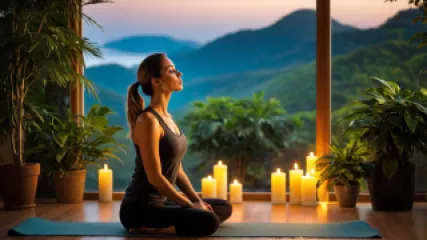Step-by-Step Guide to Deep Breathing Exercises for Relaxation
Deep breathing exercises are an effective and accessible way to reduce stress, promote relaxation, and improve overall well-being. By intentionally focusing on your breath and engaging in specific breathing techniques, you can activate the body's relaxation response, leading to a state of calm and tranquility. In this step-by-step guide, we will explore various deep breathing exercises that you can incorporate into your daily routine for optimal relaxation.
The Benefits of Deep Breathing Exercises
Before diving into the techniques, let's take a moment to understand the benefits of deep breathing exercises.:
- Stress Reduction: Deep breathing activates the parasympathetic nervous system, which helps counteract the effects of the body's stress response. This leads to a decrease in stress hormones and promotes a sense of calm.
- Improved Mental Clarity: Deep breathing increases oxygen flow to the brain, enhancing mental alertness and improving focus and concentration.
- Enhanced Relaxation: Engaging in deep breathing exercises triggers the relaxation response, which can alleviate anxiety, reduce muscle tension, and promote a general feeling of relaxation.
- Lower Blood Pressure: Regular practice of deep breathing exercises has been shown to lower blood pressure levels, promoting cardiovascular health.
- Increased Energy: Deep breathing techniques supply the body with fresh oxygen, revitalizing the cells and boosting energy levels.
- Improved Sleep: Deep breathing exercises can help calm the mind and relax the body, facilitating a more restful sleep.
Step-by-Step Guide: Deep Breathing Exercises for Relaxation
1. Diaphragmatic Breathing
Diaphragmatic breathing, also known as belly breathing, is a fundamental deep breathing technique. Follow these steps:
- Find a comfortable seated position or lie down on your back.
- Place one hand on your chest and the other on your abdomen.
- Inhale deeply through your nose, allowing your abdomen to rise as you fill your lungs with air.
- Exhale slowly through your mouth, feeling your abdomen sink back down.
- Continue this deep breathing pattern for several minutes, focusing on the sensation of your breath filling and leaving your body.
Practice diaphragmatic breathing whenever you feel stressed, anxious, or simply want to promote relaxation.
2. Box Breathing
Box breathing, also known as square breathing, is a technique that involves equalizing the length of your inhales, exhales, and pauses in between. Here's how to do it:
- Find a comfortable seated position.
- Inhale deeply through your nose to the count of four.
- Hold your breath for a count of four.
- Exhale slowly through your mouth to the count of four.
- Pause and hold your breath for a count of four.
- Repeat this sequence for several minutes, focusing on the rhythmic pattern of your breath.
Box breathing can help calm the mind, reduce anxiety, and restore a sense of balance.
3. 4-7-8 Breathing
The 4-7-8 breathing technique, developed by Dr. Andrew Weil, is a simple yet powerful exercise for relaxation. Follow these steps:
- Sit in a comfortable position.
- Close your eyes and take a deep breath through your nose to the count of four.
- Hold your breath for a count of seven.
- Exhale slowly through your mouth to the count of eight, making a whooshing sound.
- Repeat this cycle three more times.
The 4-7-8 breathing technique can help reduce anxiety, promote better sleep, and restore a sense of calm.
4. Alternate Nostril Breathing
Alternate nostril breathing is a technique commonly used in yoga to balance the flow of energy in the body. Here's how to practice it:
- Sit comfortably with your back straight.
- Place your left hand on your left knee, palm facing up, or adopt a mudra (hand gesture) of your choice.
- Bring your right hand up toward your face and fold your index and middle fingers toward your palm, leaving your thumb, ring finger, and pinky extended.
- Close your right nostril with your right thumb and inhale deeply through your left nostril.
- Close your left nostril with your ring finger, release your right nostril, and exhale slowly through your right nostril.
- Inhale through your right nostril, close it with your right thumb, and exhale through your left nostril.
- This completes one round. Continue alternating nostrils for several rounds, focusing on the sensation of the breath.
Alternate nostril breathing can help balance the mind, reduce stress, and enhance overall well-being.
5. Progressive Muscle Relaxation
Progressive muscle relaxation combines deep breathing with the systematic tensing and releasing of different muscle groups. Follow these steps:
- Find a comfortable seated position or lie down on your back.
- Close your eyes and take a few deep breaths to relax your body.
- Starting with your toes, tense the muscles in your feet for a few seconds, then release and let them relax.
- Move up to your calves, thighs, buttocks, abdomen, chest, arms, hands, neck, and face, tensing each muscle group for a few seconds before releasing.
- As you tense and release each muscle group, focus on the sensations of tension and relaxation.
- Continue this sequence, working your way up from your toes to your head, until your entire body feels deeply relaxed.
Progressive muscle relaxation can help relieve physical tension, reduce anxiety, and promote a sense of calmness throughout the body.
Conclusion
Deep breathing exercises are powerful tools for promoting relaxation, reducing stress, and enhancing overall well-being. By incorporating these techniques into your daily routine, you can tap into the mind-body connection and experience the transformative benefits of deep breathing. Whether you choose diaphragmatic breathing, box breathing, 4-7-8 breathing, alternate nostril breathing, or progressive muscle relaxation, find the technique that resonates with you and make it a regular practice. Embrace the healing power of your breath and take proactive steps towards holistic well-being.






